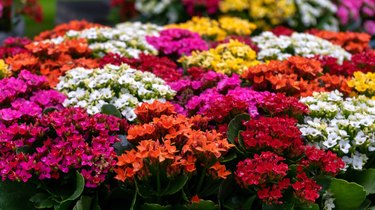
Kalanchoe (Kalanchoe blossfeldiana) is a flowering succulent that can be grown as a perennial outdoors in USDA plant hardiness zones 10 and 11. In other areas of the country, kalanchoe can be planted outside in a container for the summer and then moved back indoors before the first frost.
Kalanchoes develop their flower buds when days are short and nights are long. As days begin to shorten in the fall, the plants exposed to natural light will start developing flowers in early October and bloom about three months later in January.
Video of the Day
Video of the Day
Kalanchoes are fairly easy to grow, but they do require some cutting back during the blooming period to remove dead flowers, a process known as deadheading. They should also be cut back after they finish flowering to prepare them for the next flowering season.
Things You'll Need
Disinfecting wipes
Planting pot
How to Cut Back Blooming Kalanchoe
1. Clean Your Garden Shears
Wipe the blades of your garden shears with a disinfecting wipe before you start trimming your kalanchoes. Each time you move to a new plant, clean the blades with a new disinfecting wipe to help prevent the spread of diseases from one plant to the next.
2. Remove the Dead Flowers
Use your fingers to pinch off any flowers that have died and dried up. If you prefer, you can snip off the dried flower heads with your shears. While removing the flowers, snip off the dried stems to where they branch off the main plant. Pinch off or snip away any dried leaves you see on the plant.
3. Shape the Plant
Evaluate the plant to see if any of the stems look leggy. Snip leggy branches by about one-third their length to help keep the plant in a compact shape.
How to Cut Back Kalanchoes After Blooming
1. Evaluate the Plant's Shape
Locate branches that have grown too long or that don't conform to the rounded, compact appearance a kalanchoe should have. Cut these branches back to about one-third or all the way to the base if you want to eliminate them entirely.
2. Remove Dead and Unhealthy Stems
Cut away any stems that look dead or unhealthy.
3. Repot the Kalanchoe if Necessary
Determine if the plant needs to be repotted to a larger pot. Signs that the plant needs a new pot include:
- Roots growing out of the drainage holes.
- The potting mix in the container always dries out quickly.
- The plant seems to have stopped growing.
If any of these signs are present, move the kalanchoe to a planting pot that is one size larger than its current pot.
Tip
You can root the shoots that you snip off a kalanchoe to grow more plants. Simply remove the bottom leaves from the stem, allow it to heal for a few days, and then insert it into a container of rooting medium. Keep the pot in a plastic bag to retain moisture and place it in bright, indirect light. The plant should develop roots and be ready to transplant in two to three weeks.